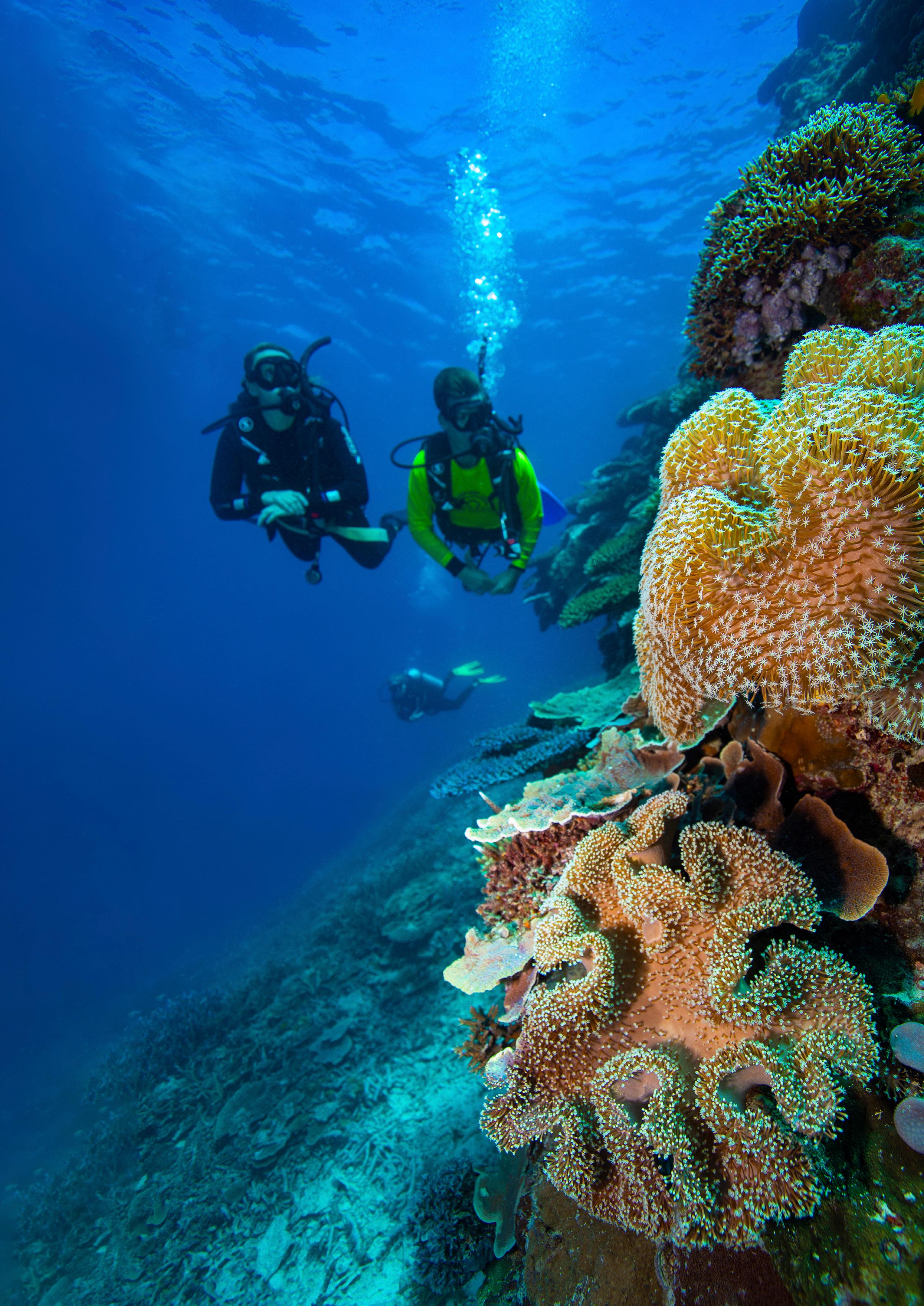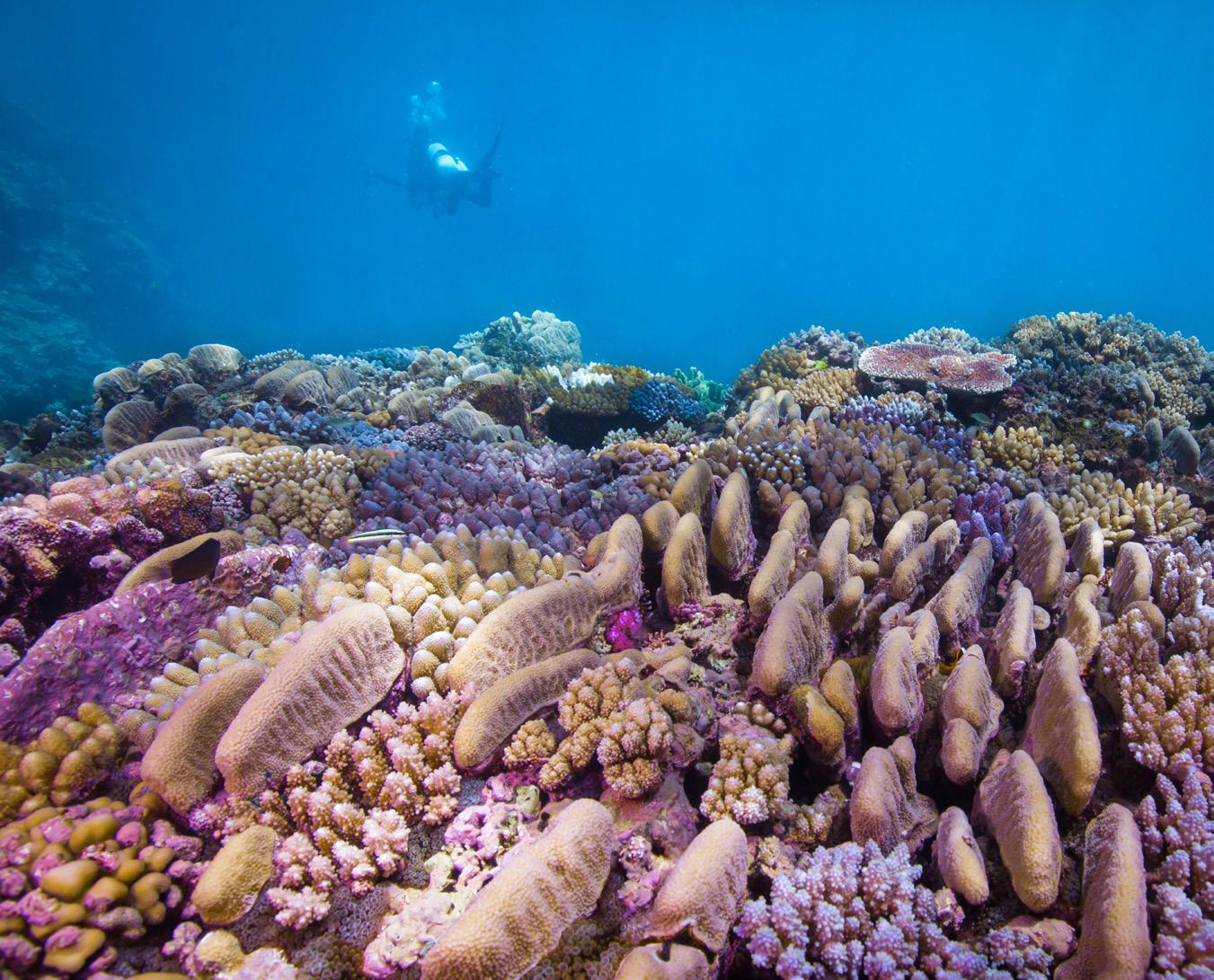
8 minute read
HOLIDAY AT HOME The Great Barrier Reef
MAIN: Diving on the Great Barrier Reef; OPPOSITE: Life thrives on the Reef; Diving with turtles; Meeting new friends
WHERE THE W I L D T The world’ s largest coral reef system is teeming encounters and best of all, it’ s in our own backyard H INGS ARE with natural
When Sir David Attenborough says “it’s the most magical thing you ever saw in your life,” you know the Great Barrier Reef is very special. The only living organism that can be spotted from space is roughly the same size as Italy or Japan and stretches over 2,300km along the Queensland coast.
These crystal clear waters, home to a treasure trove of marine life – 1625 types of fish, 133 varieties of sharks and rays, just to mention a couple – are begging to be explored (respectfully). There is nowhere else on earth like this magnificent reef system.


Here, our favourite Great Barrier Reef highlights. 1 T HINK GREEN Help keep the ‘Great’ in the Great Barrier Reef by signing up to citizen science projects and reef research encounters. A good place to start is with a visit to Townsville’s Reef HQ Great Barrier Reef Aquarium, the Great Barrier Reef Marine Park Authority’s (GBRMPA) state-ofthe-art education centre. Home to the world’s largest living coral reef aquarium, the centre also manages a turtle hospital, showing first-hand how human-created problems, like marine debris, can have a fatal impact. Be sure to like their Facebook page – little ones will love their educational videos.
Out on the Southern Great Barrier Reef, Lady Elliot Island Eco Resort is as close as you’ll get to a carbon-neutral model, offering behind-thescenes tours of its green infrastructure. The resort generates its own power, desalinates seawater for drinking, maintains a wastewater treatment plant, recycles and stopped selling bottled drinking water in 2012. Check out the walking trails on offer; the Eco Walking Trail incorporates the first dedicated Climate Change Trail and Tour which was developed in conjunction with GBRMPA.
2BIG IS BEAUTIFUL From north to south, the wild things are hard to miss when they’re as big as whales or a hefty (up to 110kg) but inquisitive potato cod – both found in the Wild North. Down south, Lady Elliot Island stakes its claim as ‘Manta Heaven’ with good reason: PADI lists it in the Top 5 locations on the planet – alongside Hawaii, Galapagos Islands and the Maldives – to see manta rays, gentle giants with wing spans up


to seven metres and the largest brain to body size ratio of any living fish.
Renowned as being interactive with divers and snorkellers, mantas also perform a fascinating mating ritual known as the courtship train. A bit like an underwater conga line, males follow and mirror a female’s every move, sometimes for days at a time. Other big personalities on the reef taking their place in the Great 8 list (see sidebar) include Nemolike clown fish, 120-year-old giant clams, maori wrasse, turtles and, of course, sharks.

3INTO THE DEEP Unsurprisingly, scuba diving is the best way to explore the reef’s underwater wonderland up close. The father of scuba diving, Jacques Cousteau, proclaimed: “The best way to observe a fish, is to become a fish.” A big fan of the Great Barrier Reef, Cousteau named Heron Bommie (one of 16 dive sites within 15 minutes of Heron Island) among the world’s Top 10 dive locations.
For keen divers, a live-aboard boat is the best option, facilitating trips to outer reefs and, for the more experienced, plummeting Coral Sea wall dives, including the opportunity to witness a live shark feed on Osprey Reef. If scuba is not your thing, try a Seawalker tour (helmet dive) off Green Island. As one of the world’s most accessible reefs, the Great Barrier Reef is also a snorkelling paradise – kit up and get out there.
4LOVE IS ALL AROUND It’s not just the infamous heart-shaped reef that’s romantic around here. Coral spawning was first discovered by James Cook University researchers back in the early 1980s. An annual event which usually takes place in early summer, coral spawning occurs when polyps on the Great Barrier Reef simultaneously release sperm and egg bundles for fertilisation. Cairns-based dive operators Tusa Dive and Quicksilver’s Silverswift offer special night diving and snorkel tours around this event. If you’re looking for some romance yourself, experience Cruise Whitsundays’ Reefsleep adventure on Hardy Reef, or pop the question on a scenic flight over Heart Reef.
5IT’S ABOUT THE TURTLES Coral reefs may have made the Great Barrier Reef famous, but only comprise 7% of the Marine Park and World Heritage Area, which is also punctuated by 600 continental islands, 300 coral cays and about 150 inshore mangrove islands. No bucket list adventure is complete without a turtle encounter – the reef is home to six of the world’s seven species of marine turtles after all.
While Raine Island, the largest green turtle rookery on the planet (on the reef’s remote northern tip), is not accessible to the public, other popular mating and nesting sites can be found on Lady Elliot Island, Lady Musgrave Island, Heron Island, Green Island, Fitzroy Island and Bundaberg’s Mon Repos Beach (don’t miss a Queensland Parks and Wildlife Service rangerguided turtle encounter at Mon Repos Turtle Centre). November to March is turtle nesting and hatchling season.
GBRMPA offers important tips on navigating turtle traffic as hatchlings make their against-allodds dash to the ocean.
6LAND AHOY Twitchers are also in for a treat on the reef; home to 215 species of birds, including 22 nesting species of sea birds and 32 species of shorebirds. Accessible from Port Douglas, Low Isles is made up of two islands; Woody Island and Low Isle.
Offering the best of both worlds, Woody Island is uninhabited apart from a large bird population, while Low Isle resembles a picture-perfect tropical island, hugged by coral reef that you can snorkel from the beach. Lady Elliot Island, Lady Musgrave Island and Heron Island (all being true coral cays or sandy islands atop the reef) offer a similar prêt-à-snorkel adventure

INSPIRED TO TRAVEL TO QUEENSLAND? Check out our tours here

QUEENSLAND’S GREAT 8 The answer to Africa’s Big Five is Queensland’s Great 8 – here’s where to find them.
TURTLES The Great Barrier Reef is turtle central, with six of the world’s seven marine turtle species cruising through its tropical waters. Southern regions including Lady Elliot Island and Heron Island are home to turtles all year round. From November to March, Mon Repos near Bundaberg transforms into the largest loggerhead turtle rookery in the Southern Hemisphere as thousands of baby turtles hatch and make their dash for the water.
SHARKS There are more than 400 species of sharks in the world, and 50 of them can be found along the Queensland coastline with the harmless white tip and black tip reef sharks commonly found on the Great Barrier Reef. Wolf Rock, three hours north of Brisbane is famous for its congregation of Grey Nurse and Leopard sharks.
POTATO COD Growing to two metres in length and weighing more than 100kg, these giants of the fish world are more akin to underwater puppies thanks to their curious nature. The Ribbon Reefs are a string of 10 coral reefs stretching over 160km off Port Douglas. Cod Hole is a famous dive spot at The Ribbons and the name pretty much gives it away – this is a prime location to see groups of giant potato cod.

MAORI WRASSE There’s no mistaking a Maori wrasse – this distinctive fish has thick fleshy lips and such a prominent bump on its forehead that it’s sometimes known as a humphead wrasse. However, what it lacks in looks it makes up for with bucket-loads of personality. Maori wrasse love structure and can be found around the Reefworld Pontoon in the Whitsundays and the Quicksilver pontoon at Agincourt Reef off Cairns.
WHALES Australia’s eastern seaboard is affectionately known as the Humpback Highway as whales migrate throughout the region from July to November each year. Humpbacks can be spotted up nearly the entire coastline of Queensland, while the relatively unknown Dwarf Minke Whales visit the Ribbon Reefs in North Queensland for a very exclusive season from June to July.

MANTA RAYS The Great Barrier Reef is home to a variety of rays but there's no more magnificent species to meet in the wild than a manta ray. These graceful creatures have wings spanning up to seven metres – and to have one sweep within centimetres of you before gracefully somersaulting and looping away is an unforgettable experience. Lady Elliot Island is the home of the Manta ray and during the winter months, hundreds of the graceful creatures migrate past the island.
CLOWNFISH Nemo, is that you? The most famous of the Great 8, these photogenic little fish are loved globally and one of the first creatures anyone will want to spot on the Great Barrier Reef. Luckily you won’t have to try too hard to find them as they live along the length of the reef.
GIANT CLAMS These extraordinary molluscs, which can grow to 1.5 metres in length and weigh up to 200kg, feature a pretty ordinary exterior but a stunning mantle – the fleshy part protruding from the shell. It’s said that, like a human fingerprint, no two clams have the same mantle pattern or colours. Giant clams can be found across the Great Barrier Reef.







